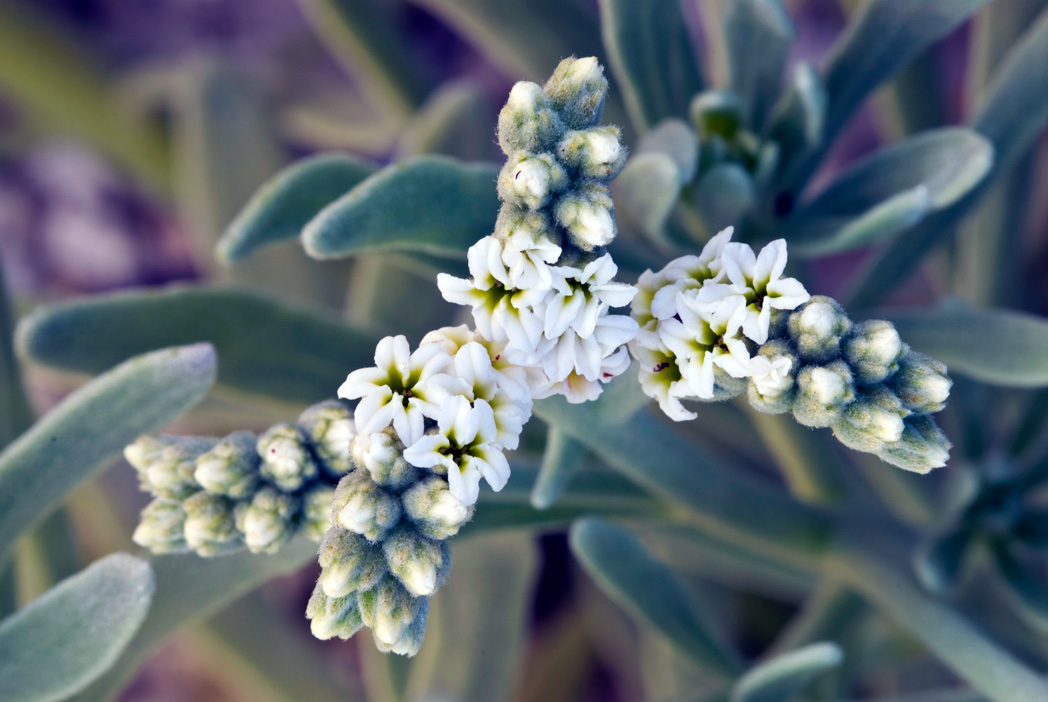Sea lavender
Sea lavender (Heliotropium gnaphalodes) by Keith Bradley. Click on terms for botanical definitions. View post as a PDF
Sea lavender is an evergreen shrub found in dunes and thickets on the Atlantic coast of Central and South Florida. This state-listed endangered species typically blooms in fall and winter, but may bloom year-round. Its small but showy flowers emit a subtly sweet scent and attract many pollinators, especially butterflies.
Sea lavender’s interesting inflorescence is a terminal, helicoid cyme, meaning its flowers are born along one side of a curved or coiled spike. Flowers may be white, pink or lavender, with a greenish, yellowish or pinkish throat. Corollas and calyces are 5-lobed. Leaves are semi-succulent and linear to spatulate with entire margins. They are covered in a silky whitish pubescence, giving the plant a silvery or grayish hue. Dead leaves persist and hang on the stem. Stems are yellowish-green and covered in soft hairs. Fruits are white ovoid drupes that turn brown or black when mature. Their corky inner texture gives them a buoyancy that aids in dispersal via ocean currents. Fruits and flowers often appear simultaneously.

Sea lavender is covered in silky hairs, giving the plant a silvery or grayish hue. Photo by Keith Bradley
Sea lavender has many synonyms, both common and scientific, including Sea rosemary, Bay lavender, Argusia gnaphalodes, Tournefortia gnaphalodes and Mallotonia gnaphalodes. The genus name Heliotropium comes from the Greek helios, or “sun,” and trepein, or “to turn.” It refers to the belief that the plants turn their flowers toward the sun. The common name “lavender” likely refers to the plant’s resemblance to true lavender or rosemary. Sea lavender’s leaves have no noticeable scent.
Family: Boraginaceae (Borage or forget-me-not family)
Native range: Brevard County south to the Keys
To see where natural populations of Sea lavender have been vouchered, visit florida.plantatlas.usf.edu.
Lifespan: Perennial
Hardiness: Zones 9B–11
Soil: Moist to dry, well-drained, sandy or calcareous soils
Exposure: Full sun
Growth habit: 3–5’ tall, equally wide or wider
Propagation: Cuttings, seed
Garden tips: Sea lavender works well in coastal landscapes as a specimen plant, in a container, or planted in mass as a hedge or screen. It is also suitable for dune restoration projects. In its natural habitat, it forms colonies that help stabilize dunes. The plant’s low-growing, spreading branches take root when covered by sand. Sea lavender is very drought tolerant once established and can also withstand exposure to salt and hurricane winds.
Plants are generally available from nurseries that specialize in Florida native plants. Visit www.PlantRealFlorida.org to find a nursery in your area.
For more information on other Heliotropium species, see:
